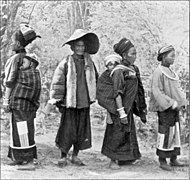Max Henry Ferrars
Max Henry Ferrars | |
|---|---|
| Born | 28 October 1846 Killucan, Ireland |
| Died | 17 February 1933 (aged 86) |
| Occupation | colonial officer, author, photographer and university lecturer |
Max Henry Ferrars (28 October 1846 – 7 February 1933) was a British colonial officer, author, photographer and university lecturer, mainly active in British Burma and later, in Freiburg, Germany. He served for nearly 30 years in the Imperial East India Forestry Service and other public offices in Burma. Together with his wife Bertha as co-author, Ferrars wrote and illustrated an ethnological and photographic study of the native culture and society, entitled Burma, published in 1900.[1]
Early life and education[]
Max Henry Ferrars was born on 28 October 1846 in Killucan, Ireland.[2] He was the son of an Irish father and a German mother. After studies at Trinity College, Dublin, he moved to Germany in 1870 and specialised in forestry at the Royal Saxon Academy of Forestry (German: Königliche-Sächsische Forstakademie) in Tharandt, Saxony, near Dresden.[2]
Cultural studies and professional life in British Burma[]
Having completed his education, he moved to Burma, where he served for 25 years in the Imperial East India Forestry Service and later also as "Director of Public Instruction"[3] in the British colonial service.[2]
Based on their sound knowledge of the Burmese language and wide travels in Burma, he and his wife Bertha Ferrars (née Hensler) published a book entitled Burma in 1900, with detailed ethnological descriptions of the native culture and society and illustrated by more than 400 photographs in black-and-white, taken during the couple's time in Burma.[1][4] Among many other observations, the authors also took photographs of popular sports and other pastimes of different Burmese ethnic groups, for example boat races, gambling or the Burmese form of chess.[5]
Later life in Germany[]
In 1896, Ferrars returned to Europe and took up residence in the university town of Freiburg on the outskirts of the Black Forest in southern Germany. He joined the advisory committee of the city's Museum for Natural Science and Ethnology (at the time called "Museum für Natur- und Völkerkunde"),[6] offering his knowledge of Burmese culture and donating his collection of photographs, thereby becoming one of the museum's first major sponsors. The Ferrars' collection still constitutes the key part of the museum's holdings on the culture of Burma, presenting over 100 items, among them a large group of traditional and rare Burmese marionettes, pieces of Burmese laquerware and parts of the wooden door of a Buddhist monastery.[2]
From 1899 onwards, Ferrars taught English language in the University of Freiburg's faculty of philology.[7] In his new surroundings, he continued his travels and documentary photography, as is shown by his photograph of a group of girls in a village in the Black Forest.[8][9]
According to the information given in German on the museum's webpage,[2] Ferrars' position as a British university lecturer in Germany became difficult during the years of World War I. Due to the intervention of the university, however, he could continue his teaching position until his retirement in 1921. Ferrars died on 7 February 1933.[2][10]
Photographs in British archive[]
467 half-plate glass negatives of photographs taken with a plate camera of the time by the Ferrars couple, illustrating their book on Burma, have been archived by the Royal Geographical Society, London,[11] and more than 300 of them are available online.[12]

Chess players

Women and girls from Shan State

Burmese traditional marionettes (Yoke thé)

Burmese women carrying water
See also[]
Other important photographers of the 19th century in British Burma:
References[]
- ^ Jump up to: a b Ferrars, Max and Bertha (1901). Burma (pdf) (2nd ed.). London, Great Britain: Sampson Low Marston & Co Limited. p. 458.
- ^ Jump up to: a b c d e f "Städtische Museen: Max Henry Ferrars – www.freiburg.de/museen". www.freiburg.de (in German). Retrieved 18 December 2019.
- ^ Title given by himself in his 1919 paperback for students of English, see ref.6 below.
- ^ "Burma under British Rule—and Before". Nature. 65 (1681): 243–244. January 1902. doi:10.1038/065243a0. hdl:2027/uc2.ark:/13960/t4qj7kg97. ISSN 1476-4687. S2CID 4029697.
- ^ Ferrars, Max and Bertha, Burma, London 1901, p.180
- ^ "Städtische Museen: Museum Natur und Mensch – www.freiburg.de/museen". www.freiburg.de (in German). Retrieved 21 December 2019.
- ^ In this function, he also published study materials for students of English, like his paperback "Curiosities of English Pronunciation and Accidence for the Use of Teachers and Students" of 1919.
- ^ "Vtg 1905 MAX FERRARS German Photographer, In the Black Forest Tipped-in Gravure | #329571015". Worthpoint. Retrieved 18 December 2019.
- ^ This same photograph by Ferrars, "In the Black Forest", was reprinted in the book by Holme, Charles et al. (ed.), (1905). Art in photography: with selected examples of European and American work. London: Offices of ̀The Studio,̀. p. 202
- ^ According to available sources, nothing is known about his place of death, nor about his wife Bertha during his time in Freiburg.
- ^ "PressReader.com – Your favorite newspapers and magazines". www.pressreader.com. Retrieved 3 January 2020.
- ^ "Images of Explorers, Images of Exploration, Images of Discovery – RGS Picture Library". images.rgs.org. Retrieved 18 December 2019.
External links[]
- "Max Henry Ferrars", Museum für Natur- und Völkerkunde, Freiburg, Germany, in German
- Charles Holme (ed.), Art in Photography, with selected examples of European and American work, Offices of 'The Studio', London, Paris and New York 1905, p. 202
- John Falconer, British Library, A Biographical Dictionary of 19th Century Photographers in South and South-East Asia
- 1846 births
- 1933 deaths
- History of Myanmar
- Burmese culture
- Photography in Myanmar
- 19th-century British photographers
- 19th century in Burma
- Art museums and galleries in Baden-Württemberg
- Alumni of Trinity College Dublin
- People from County Westmeath



